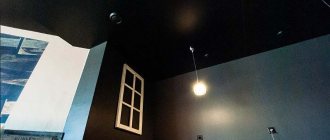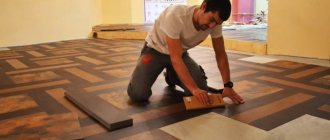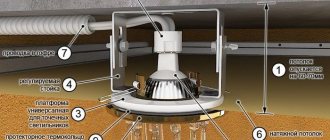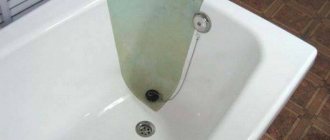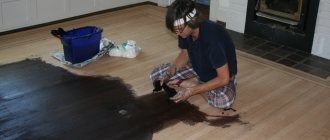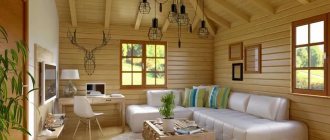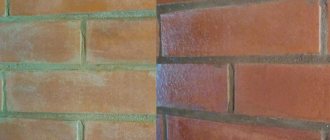SHARE ON SOCIAL NETWORKS
FacebookTwitterOkGoogle+PinterestVk
One of the popular finishing materials for decorating a room is paint. There are a large number of them, and they all differ in type and properties. Each type has certain application nuances. Ceiling paint also has a number of such moments. How to apply it correctly, what tools are best to use for this and what you should pay attention to when performing work will be discussed in this article.
If you choose the right tools and materials for painting the ceiling, you can achieve the perfect result without much effort.
General provisions
Any paint is classified according to the type of material, gloss and washability. Depending on the reflective properties of the surface, painting materials can be glossy or matte. Glossy painted ceilings are characterized by the presence of shine and high decorative characteristics. However, to apply such a coating it is necessary to carry out careful preparatory work to eliminate the slightest irregularities and defects.
As for matte paint, due to its lower reflectivity, it is able to mask minor flaws in the base base. This reduces the time and effort required for plastering or putty by an order of magnitude. An intermediate option is also available for sale - the so-called. “semi-gloss” paints: they are able to impart a certain shine to the ceiling surface, simultaneously masking minor defects and irregularities.
Depending on their ability to withstand wet cleaning, paints are either washable or non-washable. The selection of a specific option depends on the operating conditions. For rooms with a low level of pollution (bedrooms, children's rooms, living rooms), inexpensive non-washable options are quite suitable. It is better to paint a kitchen, hallway or bathroom with a washable material that can withstand regular wet cleaning with a sponge, rag and detergents without loss of decorative characteristics.
Grinding
The final stage of work is grinding the putty, which allows you to create a perfectly smooth surface for painting. Performed manually or with a grinder.
Experts manually grind “to look like a light bulb” (you can also use a simple flashlight with the same effect). By highlighting, it allows you to see the smallest defects, which are eliminated during grinding. Small defects are removed with zero-grade sandpaper, large ones - with a grater with a mesh.
Grinding scheme.
The work is carried out in a circular motion from wall to wall, which is clearly visible in the diagram. It is important to constantly monitor the quality of work. The machine method greatly simplifies the process. Otherwise, everything is done in the same way as with manual grinding.
Before painting, the ceiling is primed again.
Features of water-based paints
The main option for painting the ceiling in an apartment is water-based compositions. In another way they are also called water-dispersed. Plain water is used as a solvent here. Among the ingredients there are also film-forming materials - pigments that impart covering properties to the substance. To give the paint the necessary performance properties, special additives are introduced into its composition.
The result is a liquid suspension consisting of solid components (base, pigments and additives) suspended in the liquid. A very important point is that these particles do not dissolve and do not mix with water. As a result of application to the base to be decorated, water evaporates, after which only the polymer layer of the desired color remains.
Water-dispersed paints have a number of strengths, which makes it possible to decorate not only ceilings, but also walls indoors for various purposes:
- High adhesion
. This allows the material to fit well on almost any base, forming a reliable “adhesion” with it. If the surface preparation technology is carried out correctly, there is no need to worry about peeling or swelling in the future. - High drying speed
. Usually after 2-3 hours the painted surface can be used. - No unpleasant smell
. This makes the work much easier, because... there is no need to use personal respiratory protection. This is especially appreciated when finishing large areas. The absence of harmful toxins makes the material environmentally friendly. It can be used without restrictions in any room. - Easy to apply
. Working with water-based paint usually does not cause difficulties even for a person without painting experience.
Compositions of this type also have some disadvantages:
- Temperature requirements
. Water-dispersed paints must not be used in unheated rooms where the air temperature can drop below +5 degrees. Otherwise, small cracks will appear on the finishing surface. - Humidity restrictions
. If the humidity level in the room is high, then water-based paint simply will not be able to dry: the water in its composition will have nowhere to evaporate. - Requirements for the quality of foundation preparation
. It needs to be well leveled and sanded, because... Painting this type of slope will further highlight any imperfections in the surface.
Water-based paints are acrylic, silicate, silicone, mineral and polyvinyl acetate.
Acrylic paints for ceilings
Compositions of this type are made on the basis of acrylic resins: it is they, together with various additives, that form a decorative film on the surface of the ceiling. Among other options for painting the ceiling in a room, acrylic paint is the most popular. With its help you can decorate concrete, wood, polymer, steel, glass and plaster bases. The material dries very quickly, without emitting unpleasant odors or toxic substances.
Acrylic compounds are known for their durability. Once applied to the ceiling, they can last a long time without losing their decorative qualities. Such a surface is not afraid of sunlight, abrasion, peeling and crumbling. The created layer of paint allows steam to pass through, which is very convenient when decorating rooms with high humidity levels. The high adhesion of the material should be taken into account: once applied, it will not be easy to remove. Therefore, you need to decide in advance for what time this finishing is designed. In the process of preparing the base, it is recommended to use special antiseptic impregnations.
A special type of acrylic paint stands out - acrylate. Along with the standard set of components, latex was introduced into its composition. This makes it possible to impart additional unpretentiousness and durability to the material. Acrylate compounds adhere very well and adhere to the surface, masking various minor flaws in the form of cracks, crevices and base defects.
To enhance this effect, it is recommended to apply the material in two layers. In the future, the finished finish can be washed using delicate detergents. According to the manufacturers of acrylate paints, the base decorated with their help is able to withstand many washing cycles, with full preservation of the original decorative characteristics. The high performance characteristics of acrylate paints are expressed in the fairly high cost of this type of material.
Pivot table
Based on the compositions considered, below is a brief summary table indicating the basic characteristics of each paint.
| Item no. | Name of manufacturer, composition | Type, composition | A country | Easy to apply (1 – 10) | Drying time (hours) | On what surfaces is it applied? | Wear resistance (1 – 10) | Humidity (1 – 10) | Durability (years) | Price |
| 1 | Dulux Bindo 40 | Acrylic, latex | RF | 8 | 1 – 2 | Reinforced concrete, plasterboard, wood, chipboard | 7 | 8 | 15 | Avg. |
| 2 | Dufa Eurolatex 3 | Acrylic, latex | RF | 8 | 1 – 2 | Reinforced concrete, plasterboard, wood, chipboard | 7 | 8 | 15 | Avg. |
| 3 | Caparol AmphiSilan-Plus | Silicone | Germ. | 7 | 1 – 1,5 | Reinforced concrete, plasterboard, wood, chipboard | 7 | 6 | 20 | Avg. |
| 4 | "Halo" | Water-emulsion. | RF | 9 | 2 – 4 | Reinforced concrete, plasterboard, wood, chipboard | 4 | 2 | 5 – 7 | Low |
| 5 | Marshall "Ceiling" | Acrylic | RF | 9 | 2 – 3 | Reinforced concrete, gypsum boards. | 4 | 5 | 7 – 9 | Low |
| 6 | Tury Scandinavia Classic SW-7 Color | Water-emulsion. | Finl. | 9 | 1 – 2 | Reinforced concrete, plasterboard, wood, chipboard | 6 | 2 | 15 | Average |
| 7 | Sherwin Williams SuperPaint Interior Latex Flat | Latex | English | 7 | 3 – 4 | Reinforced concrete, plasterboard, wood, chipboard, metal. | 10 | 10 | 20 | High |
| 8 | VGT “Textured” | Acrylic | RF | 8 | 48 — 60 | Reinforced concrete, gypsum boards. | 7 | 5 | 10 | Avg. |
| 9 | Tikkurila Harmony | Water-disp. | Finl. | 7 | 1 – 2 | Reinforced concrete, plasterboard, wood, chipboard | 7 | 7 | 15 | Avg. |
| 10 | Johnstone's Covaplus Vinyl Matt L Base | Acrylic, Vinyl | English | 4 | 5 – 8 | Reinforced concrete, plasterboard, wood, chipboard | 9 | 10 | 20 | High |
| 11 | TEKNOS Timantti 20 PM1 | Acrylic | Finl. | 7 | 2 – 3 | Reinforced concrete, plasterboard, wood, chipboard, metal | 10 | 10 | 15 | Avg. |
Silicate
The basis of silicate paint is a mixture of liquid glass, talc and chalk. After application, a very hard and durable coating is formed on the surface, the service life of which reaches 15-20 years, even in the presence of unfavorable external conditions. Indoors, where there is virtually no aggressive impact on the finish, silicate paints can last an order of magnitude longer.
An important advantage of this finishing material is its high vapor permeability. As a result, water molecules can circulate freely in any direction, providing a microclimate that is favorable for humans indoors. In addition, the decorative layer will not peel off or become damp. It is still not recommended to use silicate paints in very damp rooms. But when choosing which paint is best to paint the ceiling in a room for water procedures or cooking, you need to pay special attention to silicate paints.
However, the specificity of liquid glass is such that due to its low elasticity, silicate paint is prone to cracking. This must be taken into account when looking for an option on what paint to paint the ceiling in an apartment in houses where walls and ceilings tend to shrink. Before applying this type of material, it is necessary to very carefully remove all traces of previous paint from the base (primarily this applies to organic finishes). In terms of moisture resistance, silicate paint is very similar to acrylate paint: it can be washed with a damp sponge and household chemicals.
The first (preparatory) stage of the process
Having decided to repair the ceiling, it is necessary to create convenient conditions for its implementation:
- Clear the room of all objects and furniture. For ease of finishing, it is necessary to organize access to the entire ceiling area. It is advisable to remove everything that is possible from the room - ideally, the room should be left with bare walls and floor. Those objects that, due to their dimensions, do not fit through the door, are placed in such a position that they do not interfere with the movement of scaffolding. For example, it is recommended to pull out a cabinet under the wall and place it in the center of the room.
- Protect all remaining items from dirt. Such repairs are accompanied by a large amount of debris and dust, so furniture and other items remaining in the room are carefully wrapped in film or old fabric. It is recommended to protect the floor with paper or thick film;
- Remove the chandelier and wall lights. It’s better to spend time on this than to clean them of dirt and paint later. Instead of a chandelier, one incandescent light bulb with a power of 150 W or more is hung.
Silicone ceiling paints
This type of paint became freely available relatively recently. Silicone resins are used as the main binder here. As a result, the resulting composition managed to combine two very unusual characteristics - hydrophobicity and vapor permeability. After drying, the decorative layer created on the ceiling will allow moisture vapor to pass through well, without causing the formation of a damp, stuffy atmosphere. In this case, excess moisture will not affect the ceiling material or thermal insulation.
Silicone compounds are superior to their silicate counterparts in terms of elasticity. At the same time, the finish continues to be durable and resistant to ultraviolet radiation. The good elasticity of the film formed on the ceiling allows you to protect the finish from the appearance of cracks in the event of shrinkage processes. In addition, the material smoothes out small cracks or defects in the base well, filling them flush with the surface. Silicone paint fits perfectly over the old finishing layer. The ceiling finished in this way can be periodically repainted, refreshing or changing the color of the finish.
Like other types of water-based paints, this material demonstrates excellent characteristics in terms of durability, environmental safety, fire resistance, antiseptic characteristics, drying speed and the complete absence of unpleasant odor. Among the disadvantages of silicone paints, one can highlight their high cost, which imposes additional responsibility on calculating the required amount of material.
Mineral and polyvinyl acetate
These compositions are made on the basis of cement (slaked lime) and polyvinyl acetate (this is the well-known PVA glue). Mineral paints are usually used to decorate ceilings made of concrete panels: the service life of such a coating is not very long. The scope of use of PVA-based materials is dry rooms, because... The decorative layer created with their help is not hydrophobic.
Oil and enamels
Along with water-based compositions, ceilings are sometimes decorated with oil paints and alkyd enamels. In the first of them, the role of a binding component is played by organic oil or drying oil. The latter contain alkyd varnishes and organic solvents. It should be said that materials of this type are gradually being forced out of the market for compositions for painting ceilings in a room.
The reasons for this process are as follows:
- The ceiling coating created using alkyd enamel is characterized by strength and durability, but during application it is necessary to overcome a number of difficulties. We are talking about long-term drying and the presence of an unpleasant noxious odor. The enamel layer formed after drying does not allow steam to pass through easily, which leads to the effect of blocking the room. As a result, in the bathroom or kitchen this is fraught with condensation on the ceiling.
- Oil paints have even lower performance properties. In addition to slow drying, unpleasant odor and lack of vapor permeability, the resulting finish is fragile and weakly elastic. This often leads to the appearance of cracks on the surface. The only advantage of oil paint is its low cost.
Popular manufacturers
The variety of brands producing ceiling enamels in construction stores is great. The choice of paint depends on the personal preferences of the manufacturer, financial capabilities and the effect to be achieved. Among the popular ones, we highlight 8 manufacturers who have won the trust of users.
Tikkurila
The famous Finnish brand creates high quality finishes. The materials are used when working with problematic surfaces; they work well on putty, drywall and wood. The mixture contains substances with antibacterial properties that prevent the development of dangerous microflora and can be used in the bathroom and kitchen.
Finnish paints Source cmp24.com.ua
Adhesive compositions
These materials also fall into the budget category. They are an aqueous mixture of chalk, pigment and glue.
There is the following recipe for making it yourself:
- Dry mix chalk and pigment in a ratio of 1000:35. It is important to achieve complete homogeneity of the dry mixture.
- Pour water into the dry powder (3 liters of water per 1 kilogram of mixture). It is better to do this gradually, mixing the ingredients well. The result should be a viscous liquid, reminiscent of sour cream in consistency.
- Add glue in a ratio of 80 g of wood glue per 1 kg of chalk. Starch paste can be used as an additive.
- Strain the finished mass through a metal sieve, adding the required amount of water.
It should be understood that the quality of homemade material will be quite low: in this case you cannot count on long-term operation. Still, the best option is to purchase a factory-made version of paint for the ceiling in the room.
Materials and tools
The quality of finishing the ceiling with paint largely depends on properly prepared tools and materials.
To work you will need the following:
- Roller
. It is the main tool for applying paint to the ceiling. If the area of the ceiling to be finished is small, a lightweight model will do just fine. In other situations, it is recommended to arm yourself with a wide roller, which will require some skill when handling. These tools often come with telescopic extensions that allow finishing work to be done directly from the floor. For applying acrylic and oil paints, foam or plush rollers are more convenient; for synthetic paints, mohair rollers are more convenient. - Set of paint brushes
. They help paint hard-to-reach areas, giving the surface to be decorated a decorated look. The stiffness of the bristles is selected depending on the required thickness of paint application: the higher the stiffness, the thicker the layer.
- Plastic tray
. Paint is poured into it from a can or bucket before application. Such trays have dimensions convenient for soaking the roller and a special rolling surface. - Masking tape
. It allows you to separate sections of the ceiling of different colors or patterns from each other. - Step ladder or sawhorse
. The second option is more convenient. Instead of a sawhorse, you can use an old kitchen table or the already mentioned telescopic extension that fits onto the handle of the roller. - Set of spatulas and scrapers
. They are necessary to prepare the base. - Painting sandpaper
. It is used to treat putty surfaces before painting. - Protective clothing
. Plastering and painting work is accompanied by a lot of dirt, so you should prepare special clothing for the work. These can be old things that can protect your head and body from paint and dust. It is also advisable to purchase safety glasses and a respirator.
Putty on reinforcing mesh
How to level a ceiling for painting? Quite often the method of leveling the ceiling surface using reinforcing mesh is used. It allows you to further strengthen the putty layer and protect the surface from cracking. To secure it, the ceiling is first covered with starting putty, after which the mesh is simply recessed into the layer that has not yet dried. The protruding mass is leveled with a wide spatula or a rule. This way the mesh will be completely closed. After this, another layer of putty is applied. No putty is applied along the edge of the mesh strip (about 5 cm). This is necessary so that the next section overlaps the previous one, thereby forming a single surface.
To allow the putty to dry completely, leave it alone for at least 8 hours. After this, another layer is applied to it (thickness up to 2 mm). The mass should be stretched over the surface very carefully, without leaving streaks. After the material has dried, all formed lumps, sagging and irregularities are wiped off with sandpaper. After the sanding process, you can put another thin layer of putty on the surface (read: “Do-it-yourself ceiling putty for painting”).
The finishing putty is applied over the starting putty in a thin layer (up to 1 mm). To apply it, use the widest spatula, and press it firmly against the surface. The angle at which the spatula is directed should be sharp. The smaller it is, the thinner the putty layer will be. Excess mass is removed as a rule. Without allowing the coating to dry, a second layer is applied to it. If after you apply this second layer you are not satisfied with the quality of the surface, you must allow time for the putty to dry. After which it is leveled one more time.
To make grinding the surface easier, a beam of light is directed at it at an angle. Now you can easily distinguish all the flaws. Grouting the ceiling before painting is done using fine-grained sandpaper or a special sponge.
Preparing the base
Before painting the ceiling in an apartment with your own hands, it is important to prepare the rough base as thoroughly as possible.
Operating procedure:
- Investigation of the condition of the ceiling
. Determine the scope of future work by visual inspection. On a concrete floor, it is important to notice all the gaps, cracks and joints between the slabs. Wooden ceilings must be sanded and primed, plasterboard ceilings must be sealed. - Cleaning the base from old finish
. The floor slab must be completely cleaned of the previous finish. If it is whitewash, it is washed off with water; if it is old putty or paint, it is removed with a strong spatula. It is advisable to pre-wet the wallpaper and then remove it with a spatula. Any traces of glue found must also be removed. - Priming
. For this, deep penetration impregnation is used to increase adhesion and create a waterproof film. A good option is acrylic primers. - Sealing cracks, joints and cracks
. You will need a starting putty or mortar for laying tiles: the adhesive it contains will make the seam stronger. - Continuous alignment
. If the base is more or less even, you can putty immediately. If there are defects and differences, a leveling layer of the starting mixture is laid. Putty is usually applied in 2-3 layers, which makes it possible to obtain a smooth surface. - Grinding
. The purpose of this procedure is to remove all sagging and small scratches on the putty layer. The tool used is a grater and painting sandpaper No. 120. It is better to protect the respiratory organs with a mask or fabric bandage. - Final priming
. For this, an antiseptic composition is usually used to create protection against mold and mildew.
Primer
The next stage of preparatory work is priming the surface. The operation is mandatory. It is on the floor or on the walls that you can think about the feasibility of this work; on the ceiling, the putty will stick very poorly, and under the influence of moisture from the water-based emulsion, it may even begin to fall off immediately.
Work begins after the repair solution has completely dried. Using a roller on an extended handle, the primer is evenly applied to the entire surface of the ceiling. The junctions between the ceiling and the walls and the areas where the heating pipes pass are treated with a brush.
The second layer can be applied after about half an hour, without waiting for the first layer to dry. And they putty on a completely dry surface.
Professionals mainly use the following primers:
- Ceresit ST 17 is a deep penetration primer. Located in the highest price segment. However, the price matches the quality. It provides the best adhesion between dissimilar materials: concrete and gypsum;
- GF-012. General purpose primer. Binds dust, increases adhesion between the base of the ceiling and the putty, reduces the suction of moisture from the putty solution by concrete;
- Hydroscope concentrate. Used in the bathroom, kitchen and toilet - it has waterproofing properties.
Painting the ceiling in the apartment
You can proceed to applying the paint composition only after the ceiling has completely dried:
- Prepare the paint
. This must be done in strict accordance with the instructions on the bucket. As a rule, for the first layer the material is diluted with water in an amount of 10-20%. For convenience, part of the diluted paint is poured into a painting tray that has recesses along the width of the roller. - Application
. It is recommended to start from the corner in the room farthest from the door. First, areas along the ceiling friezes and corners are painted, for which it is better to use a brush. Next comes the roller: after soaking, it must be rolled out to remove excess paint. If this is not done, it will spill onto the floor. It is most convenient to work from a construction sawhorse or an old table. So, step by step, the entire room is gradually painted. - It is recommended to apply the first layer perpendicular to the light
. In places where one area transitions to another, you need to carefully roll out the paint border so that no sagging remains. Each time you move the goat to a new place, you need to inspect the painted area from several angles. If a leak or gap is detected, it must be promptly eliminated before the paint sets. - The second layer is applied only after the first has completely dried
. Usually this takes 3-4 hours, but it’s better to take a longer break. During the second application, the roller should move perpendicular to the direction of the first layer.
How to calculate the required quantity
To paint, you need to buy the required amount of paint, so before going to the store you should calculate the area of the surface to be treated. Each manufacturer indicates the average material consumption on the packaging; accordingly, the available area must be multiplied with the consumption indicator. It is necessary to take into account the number of layers applied; each new layer will require applying less paint.
To make calculations easier, manufacturers have a consumption calculator on their website. In the special windows you need to enter the parameters of the room to be painted.
It is necessary to take into account the number of layers applied; each new layer will require applying less paint.
Ceiling paint is a good option to finish it. If you carefully prepare it for painting, then applying paint will not be difficult. The construction market presents a large number of products that can create durable coatings. In order not to make a mistake with the choice, take into account the parameters of the room and focus on the criteria described above.
